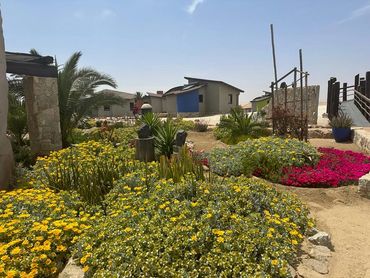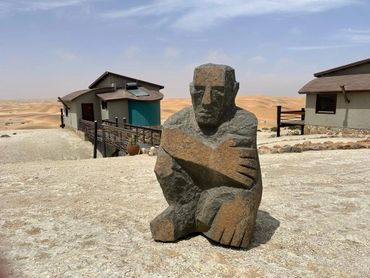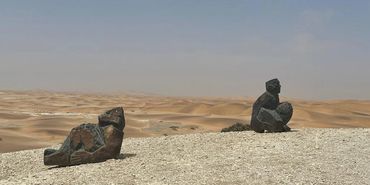After we left Etosha National Park, we headed south to Kamanjab, the Skeleton Coast, Swakopmund and then back to Windhoek. (See the map on the "Namibia (1)" page).
KAMANJAB
Ann's Lodge and Camping
In Kamanjab, we stayed at the very charming Ann's Lodge. We had a cute 2-bedroom chalet with a small kitchen, dining area. lounge and gorgeous outdoor terrace. Breakfast and dinner were absolutely delicious, cooked by the totally lovely Mina.






Otjitotongwe Cheetah Park
We were also privileged to visit a cheetah rescue property about 30kms out of town. Otjitotongwe is dedicated to the preservation of the cheetah species. It is estimated that Namibia has 2000-2500 cheetah, of which 95% are on private (game or cattle) farms. Unfortunately, some farmers have continued to shoot cheetah because of their tendency to raid stock, particularly where their natural prey species are scarce or absent.
The owners of Otjitotongwe Cheetah Parkused to shoot cheetahs because they would kill their stock, but that all changed about 24 years ago when some orphaned cubs were found on the side of the road. The owner brought them home and hand raised them. This inspired the family to dedicate their lives to the preservation of this species.
Since then, they have taken in quite a few problem cheetahs rather than letting them be destroyed. They offer to buy problem cheetahs from surrounding farms where they are suspected of raiding stock. If the family didn't rescue the cheetahs, farmers would likely shoot them.
They have a huge enclosure to live out their lives, and even though they must be fed daily as their space isn't large enough to support them to kill sufficient food, this is far preferable to the alternative.



Ann and Cheetah
Ann and Cheetah
Chris and Cheetah
Cheeta Feeding Time (1)
Cheetah Feeding Time (2)

Good catch!!
CAPE CROSS SEAL COLONY
Cape Cross Seal Reserve is the home of one of the largest colonies of Cape fur seals in the world. It also marks the spot where the first European explorer set foot on the coast of Namibia in 1486.
Attracted by the good fishing provided by the nutrient-rich waters of the Benguela current, the seals congregate on the rocky shoreline year-round, with bull seals arriving in large numbers towards the end of October, ready to fight for their territories and the right to mate with a harem of up to 60 females. Seal pups are all born in November or December and the shore is covered with a mass of bleating and mewling little bodies. The seal mothers call out for their babies when they return from fishing expeditions, ready to re-establish their bond while nursing their offspring.
I've also added some videos to the "Videos" web page.





SWAKOPMUND
Desert Breeze Lodge
Our next stop was Swakopmund and 3 nights staying at one of my favourite lodges... Desert Breeze. This gorgeous lodge is located just on the boundary of the city and has an amazing view over the Swakop River and desert sand dunes.
There is really nothing that compares to watching the sand change colour with each passing hour and then the full moon rising over the dunes. The huge picture windows allow you to gaze at the myriad of stars in the clear night sky and then wake to the red hues of sunrise gradually lighting the dunes with glorious russet hues. Simply magical! A huge thank you to Margaret, Andrea, Danie and all the Desert Breeze staff for yet another wonderful stay.
We also spent on day dune driving ... what an adrenaline rush! And our guide showed us the most amazing lizard that lives in the dunes. Strictly nocturnal , they spend the day in self-dug burrows and emerge at night to feed. Their skin has a translucent look, with some of the internal organs almost visible. They also have large webbed feet, which help them dig burrows in the sand and also allow them to easily run across the fine sand.
. I've added some videos on the "Videos" web page.










CAMP GECKO
Our Last Night in Namibia
We decided to do something a bit different for the last night of our Namibian adventure and we stayed in a 2-storey tent in a private reserve. No electricity so Ann was chief cook of our dinner on the braii. Grilled oryx with salad. Yum!
This website uses cookies.
We use cookies to analyze website traffic and optimize your website experience. By accepting our use of cookies, your data will be aggregated with all other user data.